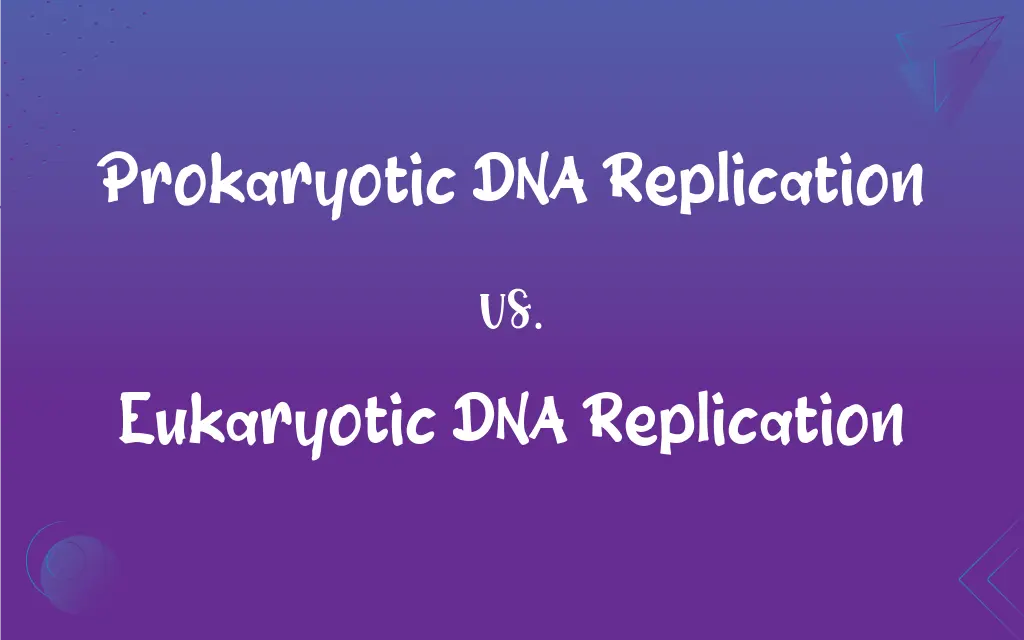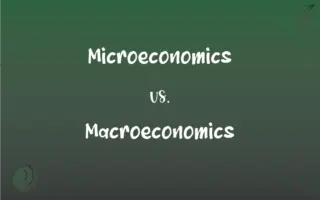Prokaryotic DNA Replication vs. Eukaryotic DNA Replication: What's the Difference?
Edited by Aimie Carlson || By Harlon Moss || Updated on October 10, 2023
Prokaryotic DNA replication occurs in simple, single-celled organisms without nuclei, while eukaryotic DNA replication occurs in complex cells with nuclei.

Key Differences
Prokaryotic DNA replication takes place in bacteria and archaea, organisms that lack a defined nucleus. Eukaryotic DNA replication, on the other hand, occurs in cells that have a distinct nucleus enclosed by a nuclear membrane.
In prokaryotic DNA replication, the process starts at a specific location on the circular DNA molecule called the origin of replication. Eukaryotic DNA replication is more intricate, with multiple origins of replication on each linear chromosome, facilitating the replication of larger amounts of DNA.
The machinery involved in prokaryotic DNA replication is simpler. Bacteria primarily use DNA polymerase III for this purpose. Conversely, eukaryotic DNA replication involves a variety of specialized DNA polymerases, like polymerase α, δ, and ε, due to the complexity of eukaryotic genomes.
Enzymes and regulatory proteins in prokaryotic DNA replication are more streamlined. In eukaryotic DNA replication, there are more sophisticated checkpoint systems to ensure accuracy, reflecting the complexity and size of the eukaryotic genome.
Prokaryotic DNA replication typically occurs faster than its eukaryotic counterpart. This is because prokaryotic cells are simpler and have less DNA to replicate. Eukaryotic cells, given their complexity, need a more meticulous and time-consuming replication process.
ADVERTISEMENT
Comparison Chart
Cell Type
Simple cells without nuclei
Complex cells with nuclei
Location of Replication
Single origin on circular DNA
Multiple origins on linear chromosomes
DNA Polymerases Involved
Primarily DNA polymerase III
Multiple types (e.g., α, δ, ε)
Speed
Typically faster
Slower due to genome complexity
Regulatory Mechanisms
Streamlined enzymes and proteins
Complex checkpoint systems
ADVERTISEMENT
Prokaryotic DNA Replication and Eukaryotic DNA Replication Definitions
Prokaryotic DNA Replication
The process begins at the origin of replication on circular DNA.
Prokaryotic DNA replication is initiated at a singular point on the bacterial chromosome.
Eukaryotic DNA Replication
The process is more intricate due to genome complexity.
Eukaryotic DNA replication ensures the accurate duplication of vast amounts of information.
Prokaryotic DNA Replication
This replication uses primarily DNA polymerase III.
During prokaryotic DNA replication, DNA polymerase III plays a central role in synthesizing the new DNA strand.
Eukaryotic DNA Replication
It employs a variety of specialized DNA polymerases.
Different stages and sections of eukaryotic DNA replication require distinct DNA polymerases.
Prokaryotic DNA Replication
The process is relatively swift and efficient.
Given its simplicity, prokaryotic DNA replication can complete in a matter of minutes.
Eukaryotic DNA Replication
Eukaryotic DNA replication involves copying the DNA of complex cells.
In humans, eukaryotic DNA replication is essential for cell division and growth.
Prokaryotic DNA Replication
Prokaryotic DNA replication involves copying the DNA of simple cells.
In bacteria, prokaryotic DNA replication ensures each daughter cell gets a full set of genes.
Eukaryotic DNA Replication
It takes place within the cell's nucleus.
Protected within the nucleus, eukaryotic DNA replication remains separated from the cytoplasm.
Prokaryotic DNA Replication
It occurs in cells without a distinct nucleus.
Due to the absence of a nucleus, prokaryotic DNA replication happens directly in the cytoplasm.
Eukaryotic DNA Replication
The replication starts at multiple origins on linear chromosomes.
Due to the extensive length of eukaryotic chromosomes, multiple starting points facilitate timely replication.
FAQs
In which cells does prokaryotic DNA replication occur?
In simple cells without nuclei, like bacteria.
How does DNA replication relate to cancer?
Errors in replication or mutations can lead to uncontrolled cell growth, a hallmark of cancer.
Are the fundamental mechanisms of DNA replication similar in prokaryotes and eukaryotes?
Yes, the basic steps are similar, but the processes and intricacies differ.
Which DNA polymerase is central to prokaryotic replication?
DNA polymerase III.
What happens if errors occur during DNA replication?
It can lead to mutations which might affect cell function or be passed to offspring.
Are there more regulatory checkpoints in eukaryotic replication?
Yes, due to the genome's complexity.
Can mistakes in DNA replication lead to diseases?
Yes, errors can cause genetic mutations that might result in diseases.
How many origins of replication do prokaryotic cells typically have?
One.
Are there more DNA polymerases in eukaryotic replication than in prokaryotic?
Yes, eukaryotes use several specialized DNA polymerases.
Is the DNA in prokaryotes linear or circular?
Circular.
What challenges do eukaryotic cells face during DNA replication that prokaryotes don't?
The need to replicate a larger genome, manage histones, and deal with telomeres.
How is the speed of prokaryotic replication compared to eukaryotic?
Prokaryotic replication is typically faster.
What makes eukaryotic DNA replication more complex?
The size and complexity of their genomes, and the need for accuracy.
Why is DNA replication essential for cells?
To ensure each daughter cell receives a complete set of genetic information.
Where in the cell does prokaryotic DNA replication take place?
Directly in the cytoplasm.
Why do eukaryotic cells have multiple origins of replication?
To efficiently replicate their larger, linear chromosomes.
How do cells ensure replication accuracy?
Through error-checking mechanisms and DNA repair systems.
How do eukaryotic cells protect their DNA during replication?
By replicating it within the nucleus, separated from the cytoplasm.
Where is eukaryotic DNA replication primarily localized?
Within the cell's nucleus.
Do both prokaryotic and eukaryotic cells use DNA helicase in replication?
Yes, both use DNA helicase to unwind the DNA double helix.
About Author
Written by
Harlon MossHarlon is a seasoned quality moderator and accomplished content writer for Difference Wiki. An alumnus of the prestigious University of California, he earned his degree in Computer Science. Leveraging his academic background, Harlon brings a meticulous and informed perspective to his work, ensuring content accuracy and excellence.
Edited by
Aimie CarlsonAimie Carlson, holding a master's degree in English literature, is a fervent English language enthusiast. She lends her writing talents to Difference Wiki, a prominent website that specializes in comparisons, offering readers insightful analyses that both captivate and inform.































































